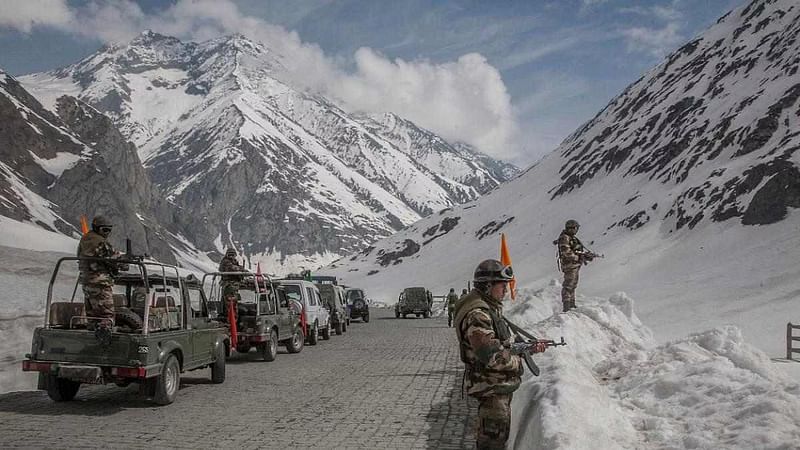
Did PLA force Galwan captives to make ‘confessions’?
Don't Miss
Footage surfaces in India-China video war PLA video was released hours after social media handles in India posted footage from a 2021 clash in Yangtse, Arunachal, showing Indian troops holding off larger Chinese force.
 |
| File image of Indian soldiers in Ladakh | Representational image | By special arrangement |
PRAVEEN SWAMI and SNEHESH ALEX PHILIP , The Print, 16 December, 2022, New Delhi: The People’s Liberation Army (PLA) compelled an injured Indian Army officer taken captive during the Galwan River clashes to make a staged confession, a video obtained by ThePrint appears to show.
The video, circulated on social media groups linked to the PLA on Thursday, was made hours after 20 Indian Army soldiers were killed and 10 captured after a melée along the Line of Actual Control in 2020.
The PLA propaganda video was released just hours after social media handles in India posted video from a 2021 clash in Yangtse, in Arunachal Pradesh, showing a small unit of the Sikh Light Infantry defending their position against far larger numbers of PLA troops.
In the PLA video, a major-rank officer is seen saying that he was ordered to cross the Line of Actual Control, and remove tents put up by the Chinese inside their own territory.
When contacted by ThePrint, Indian Army sources said they were yet to ascertain the veracity of the video.
The video appears to have been made in violation of the Geneva Conventions governing the rights of captured combatants, which state that “no moral or physical coercion may be exerted on a prisoner of war in order to induce him to admit himself guilty of the act of which he is accused”. The protections apply to all combatants in the service of nation-states, irrespective of whether a declared state of war exists.
Following a brief interrogation, in which he appears to be recording a statement on paper, Major D.S. Chauhan of the 3 Punjab Regiment is seen facing a Chinese cameraman, to make a brief statement thanking the PLA for its treatment of his men. The officer is believed to be one of the 10 Indian soldiers, including four officers, who were taken as captives by China after the Galwan clash. The captives were released three days after the 15 June 2020 clash.
China claims the entire Galwan valley lies in its territory, even though latitude-longitude coordinates for locations the country provided during official discussions show the LAC runs 4.7 kilometres to the east of the estuary. The Galwan sector was also not listed by China among 12 disputed sectors of the LAC during official negotiations in 1995.
A sensitive international issue
The use of coercion to compel captured military and diplomatic personnel to make confessions indicting their homelands has been a sensitive international issue.
The late John McCain — who later became a US senator and presidential candidate — was among several aviators tortured and forced to make confessions indicting their nation by the North Vietnam regime. Following extreme physical and mental pressure, McCain said, he eventually admitted to being a “black criminal” and an “air pirate.” The Central Intelligence Agency pilot Gary Powers, shot down over the Soviet Union on a reconnaissance flight in 1960, was also subjected to a public show-trial.
Former Indian foreign secretary K. Raghunath, together with fellow diplomat P. Vijai, were arrested and put on show-trial in Beijing in 1967, violating their diplomatic immunity.
Even though nation-states have become reluctant to link themselves directly to violations of the Geneva Conventions, the release of propaganda video has become a common feature of the digital age. The questioning of Indian Air Force officer Abhinandan Varthman after his combat jet was shot down over Pakistan in 2019 was leaked online, in an apparent effort to show he had been treated well in custody.
Tension along the LAC
The release of the Galwan video by the PLA comes amidst mounting tensions on the LAC, following a clash near Tawang in Arunachal Pradesh on 9 December. Troops positioned at an Indian post, code-named Yanki, near the famous Chumi Gyantse shrine, repulsed several hundred PLA personnel who attempted to evict them using clubs and slings. This marked the most serious face-off by troops since the Galwan clash.
Elsewhere along the LAC, the PLA has continued to build up infrastructure — notably building a bridge across the Torsa nullah and improving roads leading to the Jampheri ridge, at the junction of Bhutan, China and India. Efforts to build a similar road, though the Doka-La pass, had sparked off the Doklam crisis in 2017.
Even though China and India have been engaged in efforts to disengage troops since the Galwan clash, the PLA has sought to assert its territorial claims by force in several areas. In 2021, the PLA’s efforts led to similar clashes near Tawang as well as near the Naku-La pass.
Protocols observed by both armies forbid the use of firearms along the LAC, but the PLA has used handheld weapons like sticks embedded with nails, as well as so-called “monkey claw” slings. After the 2020 clashes, the Indian Army also began equipping its personnel with equipment of similar effectiveness.
(Edited by Anumeha Saxena)



0 Response to "Did PLA force Galwan captives to make ‘confessions’?"
Post a Comment
Disclaimer Note:
The views expressed in the articles published here are solely those of the author and do not necessarily reflect the official policy, position, or perspective of Kalimpong News or KalimNews. Kalimpong News and KalimNews disclaim all liability for the published or posted articles, news, and information and assume no responsibility for the accuracy or validity of the content.
Kalimpong News is a non-profit online news platform managed by KalimNews and operated under the Kalimpong Press Club.
Comment Policy:
We encourage respectful and constructive discussions. Please ensure decency while commenting and register with your email ID to participate.
Note: only a member of this blog may post a comment.